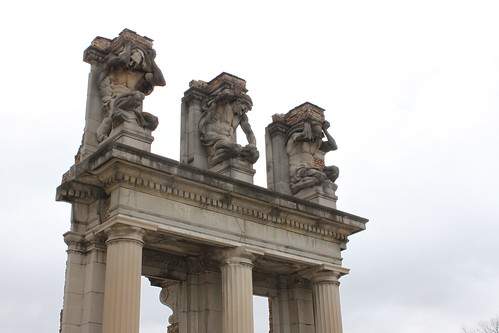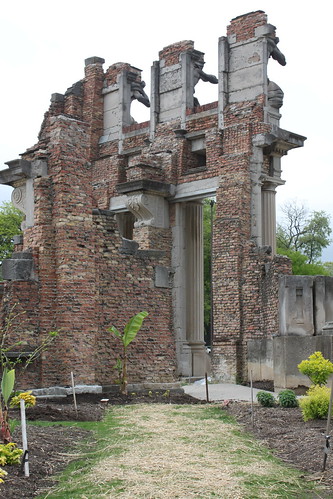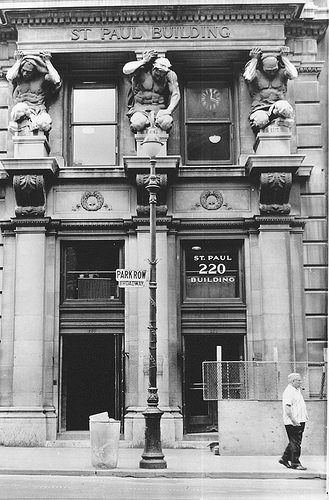Writer & Photographer / Joshua Deisler
It was one of New York City’s first skyscrapers. In 1898, it rose to become Manhattan’s tallest building. Its façade featured massive Greek columns and statues carved from Indiana limestone. It was called the St. Paul Building, but a half century later, it would be called The Ruins.
Fifty years after it graced Manhattan’s skyline, the St. Paul Building was scheduled for demolition. The building’s owner, The Western Electric Company, wanted to preserve the old columns and statues, so it planned a contest to search for the best proposals from cities around the country. With the help of Elmer Taflinger, a local artist, Holliday Park submitted a plan to house the remains of the St. Paul Building. It won the prize.
Holliday Park was rather new when the statues and columns — The Ruins — moved there. In 1916, the Holliday family donated its estate to Indianapolis, but the park officially became city property in 1932. The process of converting the land into a park, amidst the Great Depression, would take years. And by the 1950s, the park had turned from a farm to gardens and arboretum featuring maple tree species from around the world. And the old St. Paul Building would stand right in its center. 
The plan took longer than expected. In time, other old architectural features from around the city found their homes near The Ruins. The design included fountains, trees, columns, salvaged statues from the demolished county courthouse and the original façade of the St. Paul Building. Finally, in the early ’70s, The Ruins was finally dedicated.
It didn’t take long for The Ruins to fall into disrepair. What was meant to be the heart of Holliday Park soon became a burden for city funding. Parks across the city saw their budgets shrink, and The Ruins was the first to show neglect. By the early ’90s, the fountains were turned off, and The Ruins sat without much upkeep. Until today.
“We’ve known for a long time that it needed attention,” says Park Manager Adam Barnes. “The Ruins is such an iconic piece of this place that we knew we had to do something with it.”
The project would have been impossible without Friends of Holliday Park, a public charity aiming to preserve and fund the park. Its first initiatives were raising money for the park’s impressive playground and Nature Center. Just last year, the Friends group sponsored the renovation of Habitat Hall inside the Nature Center, which opened in April 2015. The long overdue renovation of The Ruins is the organization’s latest campaign.
“We wanted to hold true to the historical integrity of it,” says Adam, who notes that the idea to restore The Ruins actually began almost two decades ago. “We knew it wasn’t an option to tear it down and get rid of it. If it’s going to be here, let’s make it an asset again.”
In 2008, years after the construction of the Nature Center, the Friends group wanted to commit to another capital campaign, eventually deciding to revamp The Ruins. With the raising of $2 million, the design would feature the old St. Paul Building’s façade as the center point of Holliday Park.
“We really wanted to give it a purpose,” says Adam, who notes that connectivity between the trails, playground and Nature Center always seemed like an obstacle at Holliday Park. The massive columns and statues — the Races of Man — would be the perfect gateway to one of Indy’s most loved parks. “The big purpose for it is to help bring the whole park together.”
 The area surrounding The Ruins was soon leveled to make the site more accessible. While the architecture itself was in sound shape, it would need more than a few paths to make The Ruins the center of the park.
The area surrounding The Ruins was soon leveled to make the site more accessible. While the architecture itself was in sound shape, it would need more than a few paths to make The Ruins the center of the park.
A new parking lot just off of Spring Mill Road begins the design. From there, a promenade of sidewalks, benches and yellowwood trees will guide visitors to a fountain at the foot of The Ruins. Around the site will be different themed gardens, a large shimmer fountain, chaise lounges and various paths connecting The Ruins to the park’s other sites. The space will make the perfect venue for concerts, weddings and picnics.
“When people think of Holliday Park, they think of The Ruins,” says Adam. “When it’s finished, it’s going to be much more grand.”
And the Friends of Holliday Park have decided to keep it grand. Part of the $2 million campaign has set aside funds for the continual maintenance of The Ruins. “If we’re going to commit this amount of dollars to it, let’s make sure we can maintain it,” says Adam.
As the park celebrates the 100th anniversary of the Holliday’s gift, The Ruins will open back up to the public this summer and have an official dedication ceremony in the fall. What was once the old, neglected remains of a Manhattan skyscraper will soon become what it was meant to be — the heart of Holliday Park.





